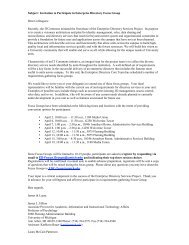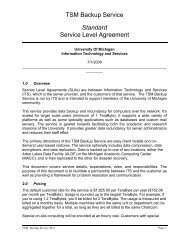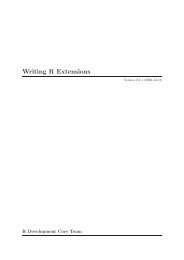What documentation exists for R?
What documentation exists for R?
What documentation exists for R?
Create successful ePaper yourself
Turn your PDF publications into a flip-book with our unique Google optimized e-Paper software.
Chapter 9: R Bugs 92<br />
9 R Bugs<br />
9.1 <strong>What</strong> is a bug?<br />
If R executes an illegal instruction, or dies with an operating system error message that<br />
indicates a problem in the program (as opposed to something like “disk full”), then it is<br />
certainly a bug. If you call .C(), .Fortran(), .External() or .Call() (or .Internal())<br />
yourself (or in a function you wrote), you can always crash R by using wrong argument<br />
types (modes). This is not a bug.<br />
Taking <strong>for</strong>ever to complete a command can be a bug, but you must make certain that it<br />
was really R’s fault. Some commands simply take a long time. If the input was such that<br />
you know it should have been processed quickly, report a bug. If you don’t know whether<br />
the command should take a long time, find out by looking in the manual or by asking <strong>for</strong><br />
assistance.<br />
If a command you are familiar with causes an R error message in a case where its usual<br />
definition ought to be reasonable, it is probably a bug. If a command does the wrong thing,<br />
that is a bug. But be sure you know <strong>for</strong> certain what it ought to have done. If you aren’t<br />
familiar with the command, or don’t know <strong>for</strong> certain how the command is supposed to<br />
work, then it might actually be working right. Rather than jumping to conclusions, show<br />
the problem to someone who knows <strong>for</strong> certain.<br />
Finally, a command’s intended definition may not be best <strong>for</strong> statistical analysis. This<br />
is a very important sort of problem, but it is also a matter of judgment. Also, it is easy to<br />
come to such a conclusion out of ignorance of some of the existing features. It is probably<br />
best not to complain about such a problem until you have checked the <strong>documentation</strong> in<br />
the usual ways, feel confident that you understand it, and know <strong>for</strong> certain that what you<br />
want is not available. If you are not sure what the command is supposed to do after a<br />
careful reading of the manual this indicates a bug in the manual. The manual’s job is to<br />
make everything clear. It is just as important to report <strong>documentation</strong> bugs as program<br />
bugs. However, we know that the introductory <strong>documentation</strong> is seriously inadequate, so<br />
you don’t need to report this.<br />
If the online argument list of a function disagrees with the manual, one of them must be<br />
wrong, so report the bug.<br />
9.2 How to report a bug<br />
When you decide that there is a bug, it is important to report it and to report it in a way<br />
which is useful. <strong>What</strong> is most useful is an exact description of what commands you type,<br />
starting with the shell command to run R, until the problem happens. Always include the<br />
version of R, machine, and operating system that you are using; type version in R to print<br />
this.<br />
The most important principle in reporting a bug is to report facts, not hypotheses or<br />
categorizations. It is always easier to report the facts, but people seem to prefer to strain<br />
to posit explanations and report them instead. If the explanations are based on guesses<br />
about how R is implemented, they will be useless; others will have to try to figure out what<br />
the facts must have been to lead to such speculations. Sometimes this is impossible. But<br />
in any case, it is unnecessary work <strong>for</strong> the ones trying to fix the problem.








